世界の VRF システム市場の概要
pVRF システム市場は、2024 年に 193.7 億米ドルと評価されました。VRF システム市場業界は、2025 年の 221 億米ドルから 2035 年には 784.6 億米ドルに成長すると予測されており、予測期間 (2025 ~ 2035 年) 中に 15.2% の年平均成長率 (CAGR) を示します。エネルギー効率の高い HVAC ソリューションに対する需要の増加、新興経済国における急速な都市化とインフラ整備、VRF システムの技術進歩が、VRF システム市場の成長を牽引しています。
図 1: VRF システム市場価値 (2019 ~ 2035 年) 10 億米ドル
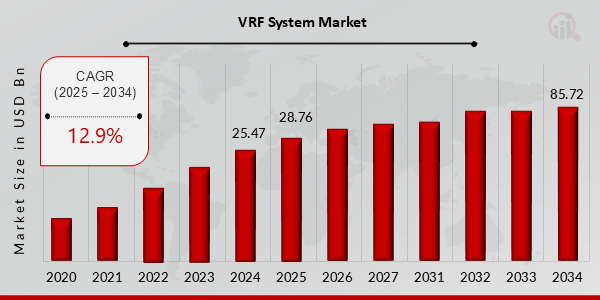
出典:二次調査、一次調査、MRFRデータベース、アナリストレビュー
VRFシステム市場 strong機会
h3スマートでコネクテッドなビルディングシステムの導入拡大 pスマートでコネクテッドなビルディングシステムの導入拡大は、VRFシステム市場にとって大きな成長機会をもたらします。現代のビルでは、エネルギー使用量の最適化、居住者の快適性の向上、運用コストの削減を目的として、IoT、人工知能(AI)、集中型ビル管理システム(BMS)などの先進技術の導入が進んでいます。VRFシステムは、これらの技術とシームレスに統合できる適応性を備えており、このトレンドを活かすのに最適です。IoT対応のVRFシステムでは、モバイルアプリや集中管理ダッシュボードからHVACの動作をリアルタイムで監視・制御できます。予測保守、リモート診断、エネルギー使用量分析などの機能により、運用効率が向上し、ダウンタイムが削減されます。これらの機能は、自動化とエネルギー効率を重視するスマートビルのニーズに完全に合致しています。さらに、オフィス、ホテル、小売センターなどの商業施設における省エネ技術の需要が、VRFソリューションへの関心を高めています。スマートグリッドや再生可能エネルギー源との統合により、VRFシステムの魅力はさらに高まります。スマートテクノロジーを導入する建物が増えるにつれ、包括的なエネルギー管理を実現するVRFシステムの役割は拡大し、メーカーやベンダーにとって市場でのプレゼンスを高める絶好の機会となります。
VRFシステム市場 strongセグメント別インサイト
h3 VRFシステム strongシステムタイプ別インサイト pシステムタイプ別に見ると、このセグメントには、ヒートポンプVRF(2パイプシステム)と熱回収VRF(3パイプシステム)が含まれます。ヒートポンプVRF(2パイプシステム)セグメントは2024年の世界市場を席巻しましたが、熱回収VRF(3パイプシステム)セグメントは予測期間中に最も急速に成長するセグメントになると予測されています。VRFヒートポンプシステムは、2パイプVRFシステムとも呼ばれます。これらのシステムは、冷媒パイプを介してすべての室内機に暖房と冷房を提供しますが、暖房と冷房を同時に行うには不十分です。この場合、室内機は冷房モードで動作しているときに蒸発器として機能します。逆に、暖房モードで動作しているときは、室内ユニットは凝縮器として機能します。2 パイプ VRF システムは、分岐コントローラがある場合にのみ、暖房と冷房を同時に提供できます。この分岐コントローラは、凝縮器と、冷媒を室内ファンコイルユニットに送る銅製分岐配管ネットワークの間に配置されます。将来拡張の可能性がある場合にのみ、分岐コントローラを選択する必要があります。2 パイプ VRF システムは、冷媒を液体の形で冷媒パイプを通して供給することにより、必要なエリアに冷却を提供します。対照的に、暖房が必要なエリアには、冷媒パイプを通してガス状の冷媒が提供されます。さらに、冷却されたエリアから抽出された熱は、refnet ジョイントを介して加熱されたエリアに向けられます。コンデンサーは、暖房と冷房のバランスを維持するために不可欠な出力差を生み出す役割を果たします。
コンポーネント別VRFシステム strongインサイト
pコンポーネント別に見ると、このセグメントには、室外機、室内機、制御システム、付属品が含まれます。2024年には室外機セグメントが世界市場を席巻しましたが、予測期間中は室内機セグメントが最も急速に成長するセグメントになると予測されています。VRFシステムの室外機は、1台の室外機で複数の室内空間を効率的に冷暖房できるように設計された可変冷媒流量(VRF)システムの動作において重要な役割を果たします。室外機にはコンプレッサーが内蔵されており、室内機の冷房または暖房需要に基づいて冷媒の流量を調整します。室外機は、配管ネットワークを介して接続された各室内機に冷媒を循環させ、異なるゾーンで独立した温度制御を可能にします。可変速制御により、必要な電力のみを使用することでエネルギー効率を高め、消費電力を削減します。さらに、室外機には熱交換器が搭載されており、冷房時と暖房時に応じて、外気から熱を吸収したり、外気へ熱を放出したりします。 VRFシステムの主なメリットの一つは、設置の柔軟性です。屋外ユニットは屋上や地上など、様々な場所に設置できるため、複雑な建物設計にも適しています。
図2:VRFシステム市場シェア(コンポーネント別、2024年および2035年)(10億米ドル)
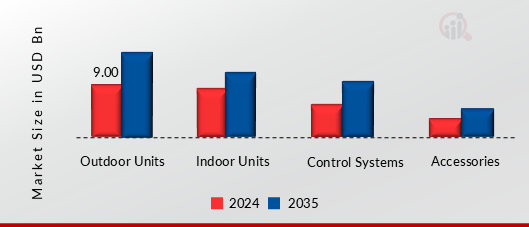
出典:二次調査、一次調査、MRFRデータベース、アナリストレビュー
エンドユース別VRFシステム strongインサイト
pエンドユース別、このセグメントには、商業用、住宅用、工業用が含まれます。商業用セグメントは2024年に世界市場を支配しましたが、住宅用セグメントは予測期間中に最も急速に成長するセグメントになると予測されています。商業用可変冷媒フローシステムは、オフィスビル、学校、ホテル、病院などの商業ビルで一般的に使用されているHVACシステムの一種です。VRFシステムは、小径の冷媒配管で接続された一連の室内機と室外機を循環する冷媒を使用することで機能します。VRFシステムはダクトレスシステムであり、つまり、建物全体に空気を分配するために空気ダクトを使用せず、ヒートポンプまたは熱回収システムを使用して建物に暖房と冷房を提供します。冷媒は、暖房または冷房が必要かどうかに応じて、室内機から室外機へ、またはその逆に熱を伝達するために使用されます。 VRF HVACシステムは、同じ室外機を利用して複数の室内機を使用することができます。VRFシステムの単一の室外凝縮ユニットには、冷媒を加圧するコンプレッサーが搭載されています。圧縮された冷媒は室内機を通過して室外機に送られ、そこで凝縮されて液体に戻ります。この液体冷媒は再び室内機に戻り、サイクルが完了します。これにより、VRFシステムは各ゾーンを個別に温度制御できるだけでなく、各ゾーンの暖房または冷房需要を満たすために必要な量の冷媒のみを循環させることでエネルギーの無駄を最小限に抑えることができます。
VRFシステム strong地域別分析
p地域別に見ると、世界のVRFシステムは北米、ヨーロッパ、アジア太平洋、中東・アフリカ、南米に分類されます。アジア太平洋市場を牽引する主な需要要因は、エネルギー効率の高いHVACソリューションに対する需要の高まり、新興国における急速な都市化とインフラ整備、そしてVRFシステムの技術進歩です。アジア太平洋地域は、中国、インド、東南アジアなどの国々における急速な都市化とインフラ整備により、VRFシステムの最大かつ最も急速に成長している地域です。これらの地域では住宅部門と商業部門の両方で建設ブームが続いており、VRFシステムのような高度で効率的なHVACソリューションの需要が高まっています。経済成長、可処分所得の増加、エネルギー効率への注目の高まりは、市場拡大に貢献する重要な要因です。中国とインドでは、都市開発と省エネ技術を奨励する政府の取り組みにより、VRFシステムの採用率が高くなっています。さらに、中流階級の増加と、都市部と郊外の両方で高品質の生活空間を求める需要により、VRFシステムの堅調な市場が形成されています。ただし、一部の東南アジア諸国におけるコスト感度や、VRFシステムの設置と保守に熟練した労働力が必要なことが、課題となる可能性があります。それにもかかわらず、アジア太平洋地域の急速な都市成長とインフラプロジェクトは、将来のVRFシステム導入にとって重要な地域となっています。
図3:2024年と2035年の地域別VRFシステム市場価値(10億米ドル)
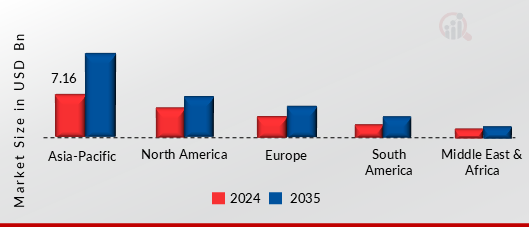
出典:二次調査、一次調査、MRFRデータベース、アナリストレビュー
さらに、アプリケーション追跡システム市場の範囲で考慮される国は、米国、カナダ、メキシコ、ドイツ、フランス、英国、イタリア、スペイン、中国、インド、日本、韓国、
世界の VRF システムの主要市場プレーヤーと競合の洞察
pVRF システム市場は、多くの世界的、地域的、および地元のベンダーによって特徴づけられています。市場は競争が激しく、すべてのプレーヤーが市場シェアを獲得するために競い合っています。激しい競争、技術の急速な進歩、政府の政策の頻繁な変更、および環境規制は、市場の成長を阻む主な要因です。ベンダーは、コスト、製品の品質、信頼性、および政府の規制に基づいて競争しています。ベンダーは、競争の激しい市場で生き残り、成功するためには、費用対効果の高い高品質の製品を提供する必要があります。市場の主な競合他社には、ダイキン、LG Electronics Inc.、Carrier Global Corporation、三菱電機、Midea Group Co.、Johnson Controls、Fujitsu General、Blue Star Limited、Voltas Limited、Bosch Industriekessel Gmbh、GREE Commercial、SKM Air Conditioning、Trane Technologies、Samsung Electronics Co.、Lennox International Inc. などがあります。 VRFシステム市場は、競争の激化、買収、合併、その他の戦略的な市場動向、そして運用効率向上のための意思決定により、統合市場となっています。
VRFシステム市場における主要企業 strongには以下が含まれます
ul2024年7月: Johnson Controls-Hitachi Air Conditioning Europeは、新型トップフロー式可変冷媒流量(VRF)空調システム「air365 Max」を発売しました。 air365 Max は、暖房、換気、空調 (HVAC) 部門の専門家、設計コンサルタント、商業ビル所有者にシームレスな快適性、エネルギー効率、簡単な設置とメンテナンスを提供するエンドツーエンドの VRF ソリューションです。
2024 年 8 月: Trane - Trane Technologies 社は、インド、タイ、ベトナム、およびアジア太平洋地域のその他の新興市場で利用可能な冷却専用の可変冷媒流量 (VRF) システムである新しい GEN Elite C シリーズ VRF システムを発表しました。この画期的なシステムは、高効率、正確な温度制御、安定した性能、柔軟な設計を提供し、オフィス、病院、小売スペースなど、さまざまな商業ビルに最適なソリューションとなっています。
2021 年 1 月: サムスンは、高級アパート、ヴィラ、バンガロー、住宅、商業施設、小売施設のわずか 0.5 平方メートルのスペースに設置できる大容量の可変冷媒流量 (VRF) 空調システムをインドで発売しました。新しいサイドディスチャージVRFシステム「DVM S Eco」は、極めて効率的で環境に優しく、静音性に優れた空調ソリューションを約束します。また、専用の室外機1台で、手頃な価格で複数部屋を冷房できます。
VRFシステム市場 strongセグメンテーション
h3 VRFシステム strongシステムタイプ別展望 ul- 米国
- カナダ
- メキシコ
- ドイツ
- フランス
- イギリス
- イタリア
- スペイン
- ヨーロッパのその他の地域
- 中国
- インド
- 日本
- 南韓国
- その他のアジア太平洋地域
FAQs
How much is the Global VRF System Market?
USD 19.37 Billion is the VRF System Market in 2024
Which Component holds the largest market share?
The Outdoor Units segment by component holds the largest market share and grows at a CAGR of 15.0 % during the forecast period.
Which region holds the largest market share in the Global VRF System Market?
Asia-Pacific holds the largest market share in the Global VRF System Market.
Who are the prominent players in the Global VRF System Market?
Daikin, LG Electronics Inc., Carrier Global Corporation, Mitsubishi Electric Corporation, Midea Group Co., Johnson Controls, Fujitsu General, Blue Star Limited, Voltas Limited, Bosch Industriekessel Gmbh, GREE Commercial, SKM Air Conditioning, Trane Technologies, Samsung Electronics Co., Lennox International Inc. are the prominent players in the Global VRF System Market.
Which System type segment led the Global VRF System Market?
The Heat Pump VRF (2 Pipe System) segment dominated the market in 2024.
このレポートの無料サンプルを受け取るには、以下のフォームにご記入ください
Customer Stories

“This is really good guys. Excellent work on a tight deadline. I will continue to use you going forward and recommend you to others. Nice job”

“Thanks. It’s been a pleasure working with you, please use me as reference with any other Intel employees.”

“Thanks for sending the report it gives us a good global view of the Betaïne market.”

“Thank you, this will be very helpful for OQS.”

“We found the report very insightful! we found your research firm very helpful. I'm sending this email to secure our future business.”

“I am very pleased with how market segments have been defined in a relevant way for my purposes (such as "Portable Freezers & refrigerators" and "last-mile"). In general the report is well structured. Thanks very much for your efforts.”

“I have been reading the first document or the study, ,the Global HVAC and FP market report 2021 till 2026. Must say, good info! I have not gone in depth at all parts, but got a good indication of the data inside!”

“We got the report in time, we really thank you for your support in this process. I also thank to all of your team as they did a great job.”
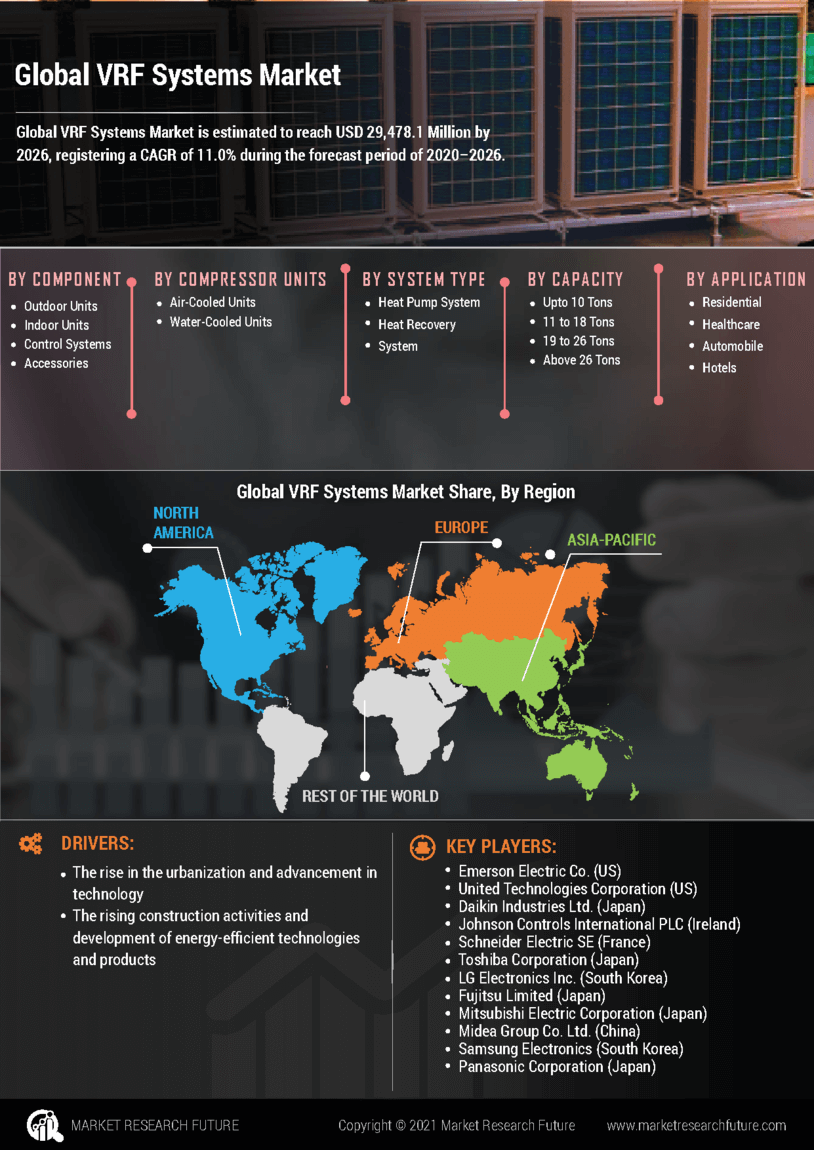
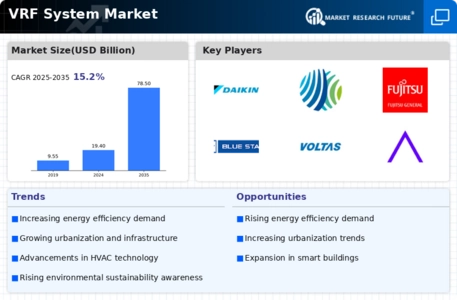
コメントを残す